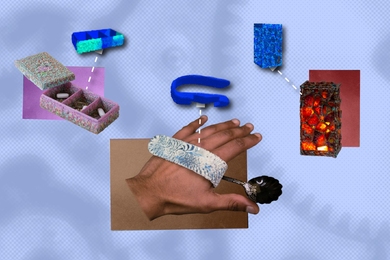A team of MIT researchers has reported the highest performance to date of transistors with channel lengths of 0.1 micron, about seven times shorter than transistors in the most advanced commercial semiconductor chips available today.
A micron is one millionth of a meter. A human hair is about 75 microns in diameter.
The MIT team reported the results in a paper presented at an international conference on VLSI (very large scale integration) technology held June 7-9 in Honolulu.
The authors of the paper are graduate students Hang Hu, Lisa Su and Isabel Yang, and Professors Dimitri A. Antoniadis and Henry I. Smith. Mr. Hu is in the Department of Physics. The others are all of the Department of Electrical Engineering and Computer Science.
The MIT transistors exhibit the highest electron velocity reported to date for a given amount of drain-induced barrier lowering, an undesirable so called "short-channel effect" which arises when transistors are shrunk below about 0.25 micron channel length. The undesirable effect was minimized by implanting ions-a chemical doping process-in such a way that the output of the transistor was well isolated from the input.
To pattern the critical portion of the transistor known as the "gate," which regulates the flow of electrons, the MIT team used X-ray lithography, a process invented at MIT.
Because X-ray lithography is believed to be compatible with the economic constraints of manufacturing, the MIT achievement could point the way to a revision of semiconductor industry practices. Other groups that have produced 0.1 micron transistors did so using electron-beam lithography (EBL) or "thinned down" patterns produced by the current manufacturing process for transistors, photolithography.
Both EBL and thinning are incompatible with manufacturing, the MIT team said-EBL because it is too slow and hence expensive, and thinning because of unreliable control.
There is growing concern that photolithography will prove to be uneconomic for manufacturing future VLSI chips with sub-0.25 micron transistors. This is because the photolithography process, which uses ultraviolet light to project images of transistors, is forced to operate in a regime near the physical limits imposed by diffraction, a phenomenon which degrades the sharpness of projected images.
"Although it has been possible in other fields of optics, such as microscopy, to operate even at those physical limits, photolithography pays a high price in terms of limited area of the semiconductor chip, poor line width control, process complexity and cost when diffraction limits are approached," the MIT researchers said.
"For these reasons it is not clear whether the evolutionary path that has been followed by the semiconductor industry for so long and with such obvious success will continue to yield profits, or whether ultraviolet light techniques will be replaced by a different lithographic process operating at a safer distance from its physical limits," the authors said in a background paper.
What the semiconductor industry would need to see in order to make a switch from its current path, the MIT team says, is either a failure of ultraviolet photolithography to be cost effective or a convincing set of demonstrations that the attractive features of x-ray lithography make it worth the gamble.
A version of this article appeared in the July 20, 1994 issue of MIT Tech Talk (Volume 39, Number 1).





